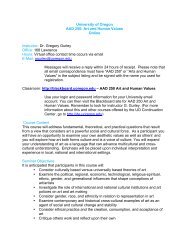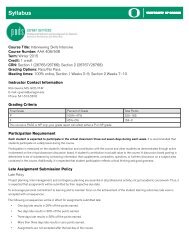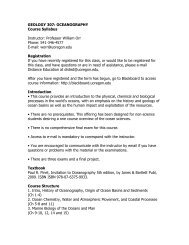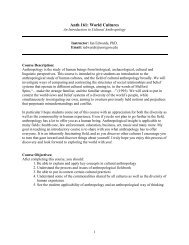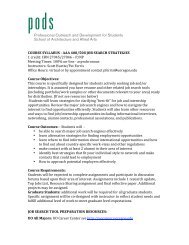Course Syllabus - University of Oregon
Course Syllabus - University of Oregon
Course Syllabus - University of Oregon
You also want an ePaper? Increase the reach of your titles
YUMPU automatically turns print PDFs into web optimized ePapers that Google loves.
ACADEMIC DISCOURSE (For assignments inthis course; adapted from R. Voelker-Morris, 2008):As with any academic forum <strong>of</strong> research anddiscourse, there are certain expectations for the waysin which a student approaches the course materials.This means that we move beyond the personal andinformal discussion found in daily venues. Studentsshould incorporate critical thinking in their work by:Framing a central question or argument that isthen backed up with proper evidence <strong>of</strong> topicknowledge. Includes original thinking aboutpossible answers to the question/argument(even if this means you may later re-frame andchange your first posed question/argument).Analyzing all topics presented by the instructorand other students in a critical fashion, goingbeyond simple (dis)agreeing statements.Interpreting connections between multipletopic areas and/or author arguments to formnew insights into the materials covered.Researching and applying outside resources tosupport arguments and statements andresearch sources that demonstrate the student isversed in the literature about the topic areas.Classifying the topics and sources into easy tounderstand descriptions <strong>of</strong> concepts presented.Articulating thoughts, arguments, topicconnections, sources, and other statements intoa cohesive and detailed writing or presentationformat in which proper grammar and writingstructures allow for easy understanding <strong>of</strong> eventhe most complex <strong>of</strong> ideas.Posing questions to the learning community forfurther consideration and research.This encompasses Critical Thinking. If you feel thatyour thoughts are not being understood by coursecolleagues, review these descriptions and apply themto your work within assignments (see Elements &Standards Model at www.criticalthinking.org/courses/Elements_standards_model.cfm).A well cultivated critical thinker:raises vital questions and problems, formulatingthem clearly and precisely;gathers and assesses relevant information, usingabstract ideas to interpret it effectively, coming towell-reasoned conclusions and solutions, testingthem against relevant criteria and standards;thinks open-mindedly within alternative systems <strong>of</strong>thought,recognizes and assesses, as need be, one'sassumptions, implications, and practicalconsequences;communicates effectively with others in figuringout solutions to complex problems.ACADEMIC HONESTY (adapted from J.Rutherford, 2005 and Southwestern CollegeIntegrative Studies Program, 1999):Plagiarism is a serious <strong>of</strong>fense. The consequences forusing the words <strong>of</strong> another without quotation marksor citation, or <strong>of</strong> using the ideas and conclusions <strong>of</strong>another without citation, are severe. In this course,such academic dishonesty will not be tolerated andmay be grounds for automatic failure on a givenassignment. Penalties may range from having torewrite an assignment, to failing the assignment, t<strong>of</strong>ailing the course.In a basic definition, plagiarism is borrowing others'words and ideas without proper acknowledgment. Ifone <strong>of</strong> your motivations for going to college is to get agood job, then you need to be able to research, think,and write on your own while giving credit to sourcesthat inspire, inform, or otherwise provide you withstatistics, ideas, etc. Gathering information andlearning from others' knowledge means you havedone your homework.The perspectives <strong>of</strong> others should enhance andsupport your research, thinking, and writing. Others'opinions should not take the place <strong>of</strong> your opinionbut emphasize its validity. Your synthesis or analysis<strong>of</strong> the topic will more likely be accepted as valid if theassignment shows you have done your research.Classroom practice assists skills in the work world.References need to be cited whenever used within thebody <strong>of</strong> the written assignment. When using 3 ormore words in a row from another author/source,they must be placed in quotation marks and cited --quote them exactly. You should also cite ideas(including summaries and paraphrases) you usefound in the work <strong>of</strong> another author/source that arenot your original work or which fall under the realm<strong>of</strong> common knowledge. Paraphrasing should bewritten in your own language and style. Also includea References/Works Cited page at the end <strong>of</strong> anywritten assignment so that references may be foundby any reader for further information. If it is foundthat you have copied work from others, withoutcredit, your work is more likely to be rejected.If you have questions about citing sources, pleasecontact me, consult the advisors at the Writing Lab inPLC, or use a writing guide from the library.Citation styles include:APA: http://apastyle.apa.org/MLA: http://www.mla.org/styleChicago:www.chicagomanual<strong>of</strong>style.org/home.htmlYou may Google styles listed above for other guides.Further information regarding academic dishonesty:http://libweb.uoregon.edu/guides/plagiarism/students/. Student Conduct Code:http://studentlife.uoregon.edu/judicial/conduct/code.htm.



